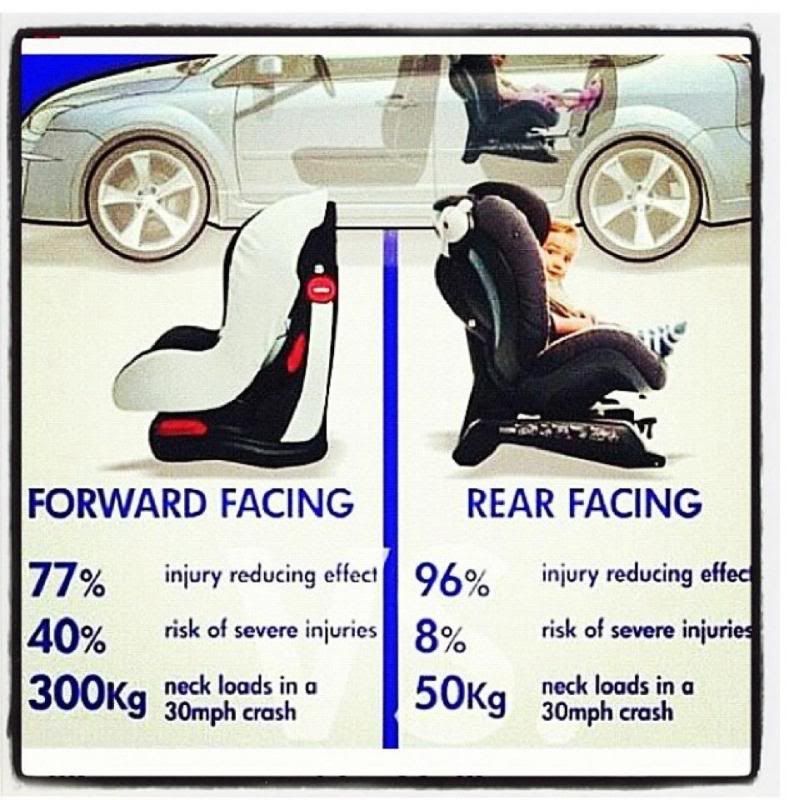*My only recent ERF picture*
Now, let me start this by saying I am not bashing mamas who FF at 1 year and 20lbs. I am all for ERF with my kids and I don't think anyone will change that. My 2.5 year old, who is 26lbs and 32in tall, is still RFing - and he loves it. There is a wealth of information at your fingertips mamas, use it! Do your research! What I hope to do with this post is dispel some ERF myths.
For instance, "FF at 1 and 20lbs is just as safe as RF past that."
Quite frankly, no, it's not. Even the AAP (American Academy of Pediatrics) recommends RFing until 2 years old and 30lbs. Why, though?
In most accidents, a RFing baby/toddler is 5 times safer than a FF baby/toddler. The seat takes the bulk of the impact and helps to distribute it over the whole body, thus protecting your child moreso than if the seat was FF and didn't take most of the damage. When a child is facing forward, their head and neck move forward abruptly and it can cause neck/spinal damage.
"My child won't be comfortable RFing. He's too tall."
If he's not exceeding the seat's requirements, he's not too tall. My son is 32 inches tall, his feet reach the back of the seat, and he's comfortable even on long car rides. There are many positions for a baby/toddler to put his legs when RFing. My son likes to sit cross legged... or with his knees bent, or resting on the top of the back seat, or out to the sides of the car seat. He never complains that he's uncomfortable, but honestly, I think that a small bit of discomfort is worth his safety.
"I don't want to keep her in an infant seat."
I'm not sure where parents get the notion that to ERF they need to keep their child in an infant, or "bucket" seat. That's absurd. A convertible seat works (generally) from 5lbs to that specific seat's weight/height requirements. There's absolutely no need to keep her in an infant seat, which she'll likely quickly outgrow anyway.
"I'm on a budget, I can't afford to ERF."
Budget? Welcome to my life! We have a convertible Cosco seat, nifty design, double cup holders, 5lbs all the way to 40lbs and 40 inches. Side impact protection, all that great stuff. And it didn't burn a hole in our bank account. This awesome seat cost us a grand total of $60, and it wasn't even on sale. We paid full price, brand new, and only $60. Pretty nifty, I think. And it gets better - if you get a seat like this and plan to ERF it could actually be cheaper for you in the long run. Instead of shelling out $60-$250 for an infant seat and $60-$350 for the convertible car seat you're going to buy just to FF in when your little one outgrows her infant seat, you could buy the convertible and be done with it. Just buy one seat! Nicer to your wallet, and safer for that little bundle of joy you brought into the world.
"My son gets bored, he needs to face forward or he'll cry."
If he's never FF, he doesn't even know what he's "missing". All you've gotta do is pack some toys for the ride! A car ride will bore any toddler/child, anyway. Another thing that may help is installing a shatter-proof baby mirror on the backseat - so you can see your kiddo, and he can see you, too. Bring a CD of some fun songs he likes, or a picture book for him to read. His safety is more important than him being bored, mama!
*And please, please keep these things in mind:
- A chest clip is a chest clip for a reason. It should be placed on the chest, NOT the belly. Placing a chest clip over the belly could result in severe internal damage in the even of an accident.
-Straps should be snug. You should not be able to pinch them. They also should not be twisted (or washed for that matter). All of these things affect the quality of the straps and their ability to help in an accident.
-Winter jackets should NOT be worn in a carseat. These jackets are puffy and will compress in a car accident, therefore compromising your child's safety and increasing the risk of your child being expelled from the car seat.
-Make sure your baby/toddler has not exceeded the height/weight requirements of the car seat. The seats only test safely to those requirements.
-Don't buy a used car seat! A seat should be replaced after every crash, as damage is done to the seat in a crash and will be significantly less effective. Many people selling their old car seats neglect to mention whether the seat was in a crash, and sometimes even lie about it to get rid of the seat.
-Check your seat's expiration dates. Yup, car seats expire! Typically 4-7 years after the manufacture date. You can normally find the date imprinted somewhere on your seat. It's important to toss an expired car seat because the plastic shell can become brittle and not protect well in an accident, and the straps can wear down (even if they're not being used) and give in an accident, expelling the child from the seat.
Remember mamas (and dads!) do your research! A couple of hours of research could save your child's life. A fair trade if you ask me! :)



No comments:
Post a Comment